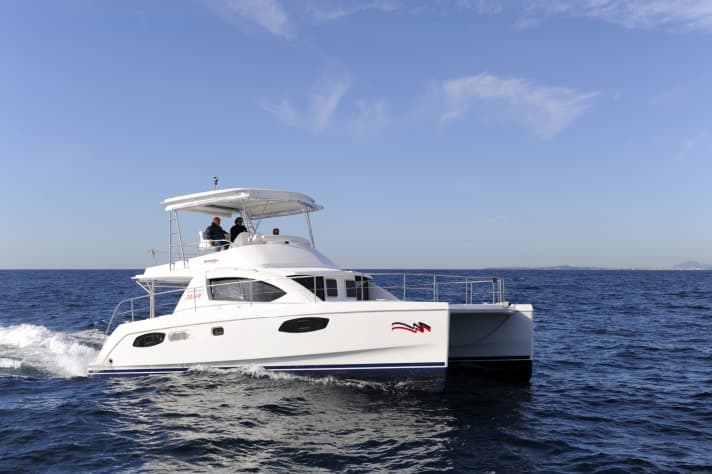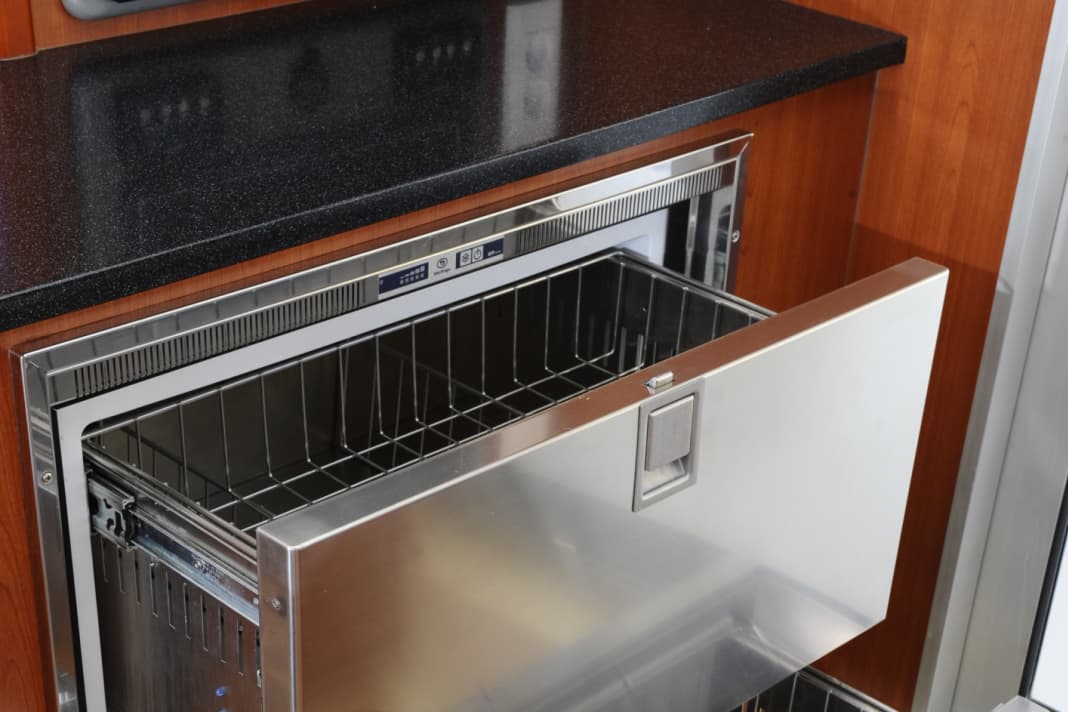







The Robertson and Cain sailing catamaran shipyard from South Africa has added a motorised catamaran to its range, the Leopard 39 PC. The "P" stands for "Power", the "C" for "Catamaran". In addition to the 39 PC, there is also a Leopard 47 PC. However, we are not talking about the catamarans we know from Formula 1 races or their "civilian relatives" from the USA or Norway, where speed is only considered to be above 60 knots.
This is more about the quiet and cosy class, a - quite wide - displacer. With two engines and counter-rotating shaft drives, manoeuvring in confined spaces is no problem. One drive lever "forwards" and the other on "reverse" means turning on the spot. However, if you want to get out of narrow berths, you need a second person to occupy the tip of the hull lying on the pier so that you can turn out in reverse using the power of the opposite engine.
It is generally better to have a second person on board in the harbour, because the view from the helm station - there is only one on the upper deck, i.e. on the fly-bridge - is limited both when sitting and standing aft. You can see neither the stern nor the starboard side of the boat. Only the view to port is OK, because the helm station is also on this side. You can also only see the bow of the boat when you are standing, as there is a seating area with a table and upholstered tubular backrests in front of the steering position. There is never a view of the boat to starboard from the steering position.
We sail the Leopard 39 PC on the Mediterranean off Nice in wind, sunshine and a swell that has grown to around one and a half metres by the end of the test day. Engine power does not play the same role in a displacement boat as it does in a glider. Nevertheless, Leopard installs two well-dimensioned Yanmar diesel engines in the 39 PC, each delivering 110 hp to the shaft drives. This is enough to accelerate the boat to a maximum of 15 knots at full throttle in an emergency.
Otherwise, you move forwards at cruising speed between 6 and 8 knots, within the theoretical hull speed, which is the optimum range for the 39 PC. In terms of range, this means: the slower, the greater the radius of action. In the case of the test boat, this theoretically ranges from just under 900 to just over 200 nm plus 15 % reserves. And between 6 and 8 knots of speed, the fuel is sufficient for a non-stop distance of between 550 and 400 nm plus reserve. That's good.
Displacers produce "nothing extreme", so there are no extreme manoeuvres. At full speed, a full circle measures about five boat lengths with barely perceptible centrifugal forces and about four boat lengths at slow speed, and you can't get a catamaran to roll anyway. Double-hulled boats generally have a different rolling behaviour to monohulls, which some people have to get used to.
With this knowledge, we are pleasantly surprised at how harmoniously our test boat behaves. Although there is a strong swell, we have to look for waves on other pleasure craft or ferries. The Leopard 39 PC handles them with aplomb, which is to be expected from a boat certified for the high seas (CE category A). The boat's CE plate also indicates that the classification changes depending on the number of people on board. So if there are (maximum) 26 people on board, weighing no more than 2730 kg with luggage, the 39 PC is only certified for inland waters in class D.
However, the 39 PC does not offer 26 berths. There are three cabins and two bathrooms in the two hulls. While the starboard hull is reserved for the owner, four guests sleep in the port hull and share the day toilet with the others, which has a separate shower. The saloon with sofa, table and galley are located between the hulls. The saloon and aft deck are on one level. The foredeck resembles a large platform where sunbeds and chairs can be placed.
The storage space on deck is not as plentiful as in the living area. The tank compartments aft in the hulls, the stowage spaces under the seating aft and the anchor locker/generator stowage space in front of the saloon are used.
Handrails and handholds are strategically distributed around the boat, and except for the aft area, the boat is surrounded by a proper railing. Manual and electric bilge pumps are standard, as are automatic fire extinguishing systems in the engine compartments. No water alarm in the diesel pre-filters is a shortcoming, but exhaust temperature sensors are commendable. The main battery switches for the engines are located in the hallway dovetail nests in front of the aft cabins and for the boat inside the galley. A large switch panel in the saloon contains thermal fuses.
The 39 PC is equipped ready to go, with a log, plumb line, compass, certified navigation lights, enough mooring cleats and anchor windlass including chain and anchor, to name just a few things. But everything else that makes life on board "sweeter" is on the accessories list, such as the 230 V shore connection, electrically operated toilets and the fixed bimini on the fly. The biggest chunk, however, is the 31,350 euro freight costs from South Africa to Nice.
Conclusion: The 39 PC is a long-distance runner with plenty of space. The workmanship is above average - with small "outliers" at the top and bottom.

